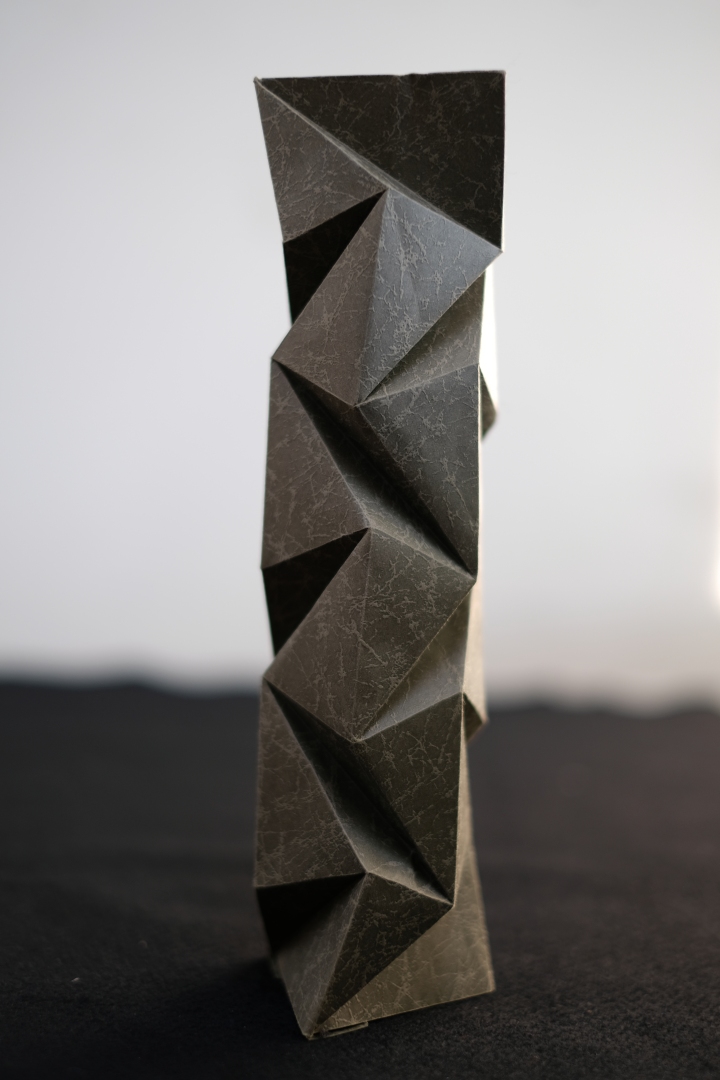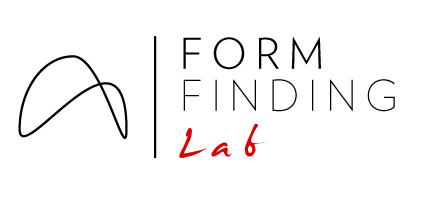Tomohiro Tachi is an associate professor in graphic and computer sciences at the Graduate School of Arts and Sciences, the University of Tokyo. He studied architecture and received his Masters and Ph.D. degrees in engineering from the University of Tokyo. He has been designing origami since 2002 and exploring spatial and kinematic origami through computation. Tachi developed several software tools for origami design. “Origamizer” (2008) generates the crease pattern on a sheet of paper that folds to a given three-dimensional polyhedral mesh. In 2017, he collaborated with Erik Demaine to prove that any polyhedron can be folded from a sheet of paper through an improved algorithm of Origamizer. Tachi is also active in proposing new computational methods for designing a class of origami called rigidly foldable origami, i.e., a deployable system composed of rigid panels and hinges. One of such design methods is the generalization of Miura-ori, which won the Hangai Prize in 2009. The method is implemented in “Freeform Origami” (2010), which, together with other computational origami tools, is available from his website. In addition, Tachi collaborated with Koryo Miura to first propose the idea of cellular origami. This work won the Tsuboi Award in 2013. The cellular origami concept is now a standard technique for creating mechanical metamaterials. Tachi is now leading the Origami Group of Structural Morphology Group in IASS, aiming to bridge different aspects of spatial structures through geometry and graphics.
- Stainless Steel freeform Resch Tessalation, 2013, see flickr & materializing.org
Demi Fang: What is something you are currently working on that excites you?
Tomohiro Tachi: I have been working on structural origami. Currently, I am interested in the self-folding scheme for fabricating spatial and reprogrammable structures. Origami allows us to build 3D functional shapes out of a 2D flat sheets. It further allows us to reprogram a single sheet pattern into different mechanisms and functions. However, the difficulty of the folding process rapidly grows as the complexity of the pattern increases. This phenomenon is related to the branching behavior at the flat singular state. This is annoying from a practical point of view but scientifically exciting and challenging.

DF: Describe the collaborations in your work. What do you think makes for successful collaborations? In what ways do you blend the technical and creative aspects of your work?
TT: I collaborate with mathematicians, computer scientists, artists, and engineers. The fun thing about cross-disciplinary collaboration is that something you thought you knew may turn out to be unsolved problems or vice versa. Viewpoints from different fields provide us new interpretations to existing problems and create exciting questions. For successful collaboration, learning each other’s “language,” or the basic concepts and the way of thinking is helpful.

DF: What methods do you use to fuel creativity? How do you work?
TT: My work is curiosity-driven. When I try to fabricate something out of real materials, I find generalizable problems. When I try to solve such a problem, I encounter 10 more problems in the process. So I keep puzzled by new problems.
DF: What is the importance of making physical models in your research work?
TT: Visual and tactile interactions with physical models give a different channel for understanding structures and concepts apart from the logical way of understanding them. Increasing the number of channels is helpful in the design which requires nonlinear processes.

- Cellular structures composed of rigidly foldable origami sheets exhibits properties as mechanical metamaterial.
DF: Your academic background is in architecture & engineering; at what moment in your life did you become drawn to origami specifically?
TT: I was initially interested in the connections between art and geometry in my undergraduate years. This interest motivated me to revisit my childhood hobby of origami and to major in architecture, independently of each other. The two concepts slowly got integrated during my study.
DF: What excites you about the future in your field?
TT: One of the future dreams for origami researchers is to enable a new 4D printing technique based on self-folding. Imagine you print a computed pattern on a sheet material, put it in an oven for a minute, and then the material folds it into the shape you desire. Origamizer tells you how to compute a crease pattern from any 3D polyhedral shape, but we don’t know a right way to make the pattern have a valid and controllable folding process. This requires establishing the theory of self-foldability, which is one of the biggest technical challenges in my work.

DF: What is your favorite fold pattern and why?
TT: There are too many favorite patterns to answer. I do like seeing wrinkle patterns that appear on thin surfaces such as clothes. Check out the wrinkle patterns on your pants.
DF: What is your advice to young children wanting to be origami artists and mathematicians?
TT: Origami is an exciting example showing that scientific problems arise from everyday objects like a regular sheet of paper. Considering that science is, in fact, a reverse engineering process of natural phenomena, picking up some artifacts, e.g., products, art, and toys, and reverse engineering them is a fun and effective way to train your scientific attitude. In this way, you can be productive in creating problems.
DF: What question are you never asked and would like to be asked? What would be the answer?
TT: My favorite artist: M. C. Escher
Featured Image: Freeform origami tessellation folded from a single sheet metal. The pattern is computed using Freeform Origami by solving geometric constraints required for fabrication.
This interview originally appeared in the proceedings for IASS 2018 at which the interviewee was a keynote speaker. These interviews make their first appearance online in this co-published series between this blog and the Digital Structures blog with the aim of inspiring a broader audience with the thoughts and insights of these outstanding individuals. Stay tuned on both blogs for more!




